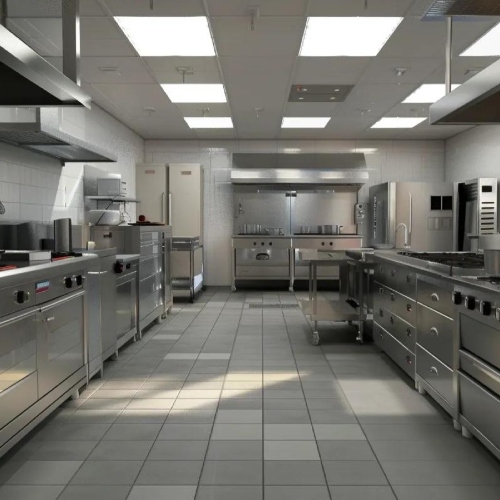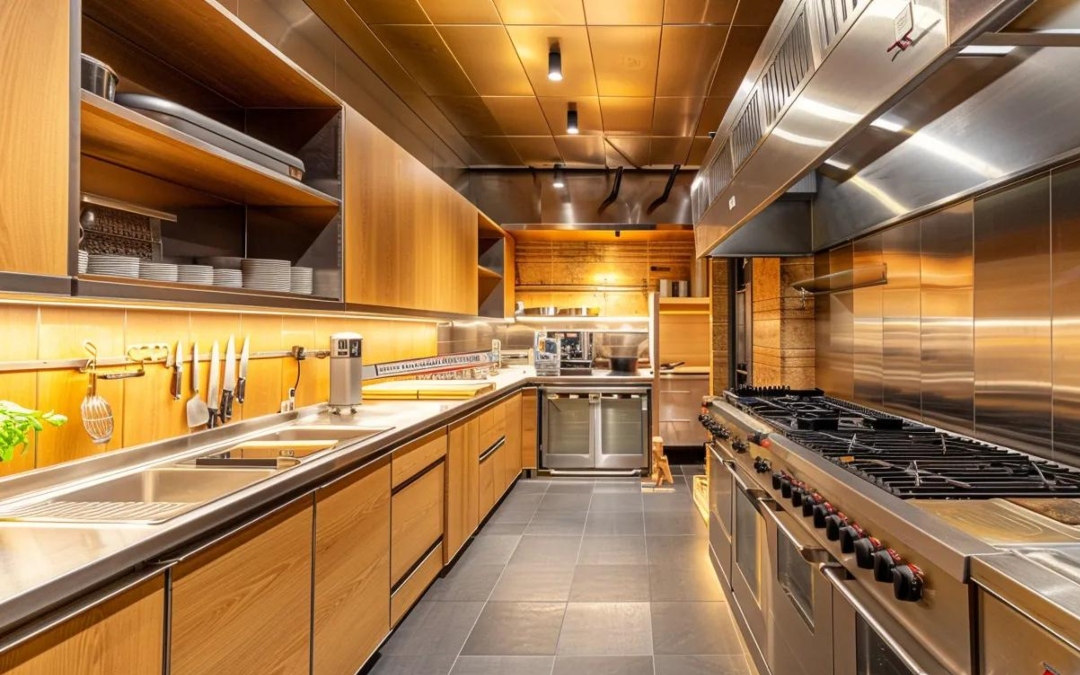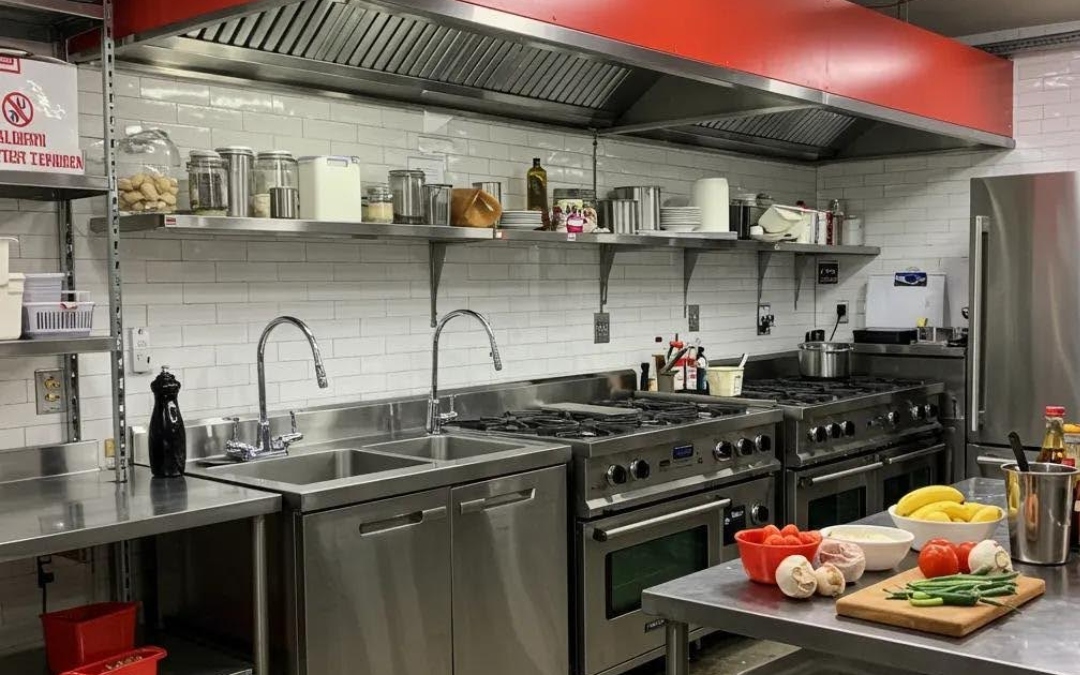A regular kitchen serves home cooking needs while a commercial kitchen produces food for business sales. Commercial kitchens focus on speed and food presentation for customers. Home kitchens emphasize comfort and personal use. The primary distinction lies in production volume, equipment grade, regulatory requirements, and operational scale.
What Is the Main Difference Between Regular and Commercial Kitchens?
The main difference is purpose and production volume. Commercial kitchens prepare food to serve customers in real time. Regular kitchens make meals for family consumption. Commercial kitchens serve far more people and prepare many more meals per day than home kitchens. The focus in commercial settings centers on flexibility, speed, and consistent food presentation. Home kitchens prioritize convenience, aesthetics, and family comfort.
Regular kitchens cook for 2 to 8 people daily. Commercial kitchens cook for 50 to 500+ people daily. Regular kitchens operate 1 to 3 hours per day. Commercial kitchens run 8 to 16 hours per day. Some operations continue 24 hours to meet delivery demands or multi-shift schedules. The workflow in commercial spaces follows production line principles rather than casual cooking patterns.
Commercial operations require staffing with multiple specialists working simultaneously. Regular kitchens function with one or two family members cooking at their own pace. The pressure and timing requirements differ dramatically between these two environments. Commercial kitchens must deliver consistent quality at scale while home kitchens adapt to family preferences and schedules without strict deadlines or customer expectations.
How Big Are Regular Kitchens Compared to Commercial Kitchens?
Regular kitchens measure 100 to 200 square feet while commercial kitchens need 1,000+ square feet. An industrial kitchen measures 2 to 20 times larger than a commercial kitchen, sometimes even 50 times the size of a typical restaurant kitchen. The average commercial kitchen spans approximately 1,000 square feet though this varies by restaurant type and service model.
Regular kitchens fit one or two cooks comfortably. Commercial kitchens accommodate teams of 5 to 20 workers during peak service hours. Space requirements increase with customer volume and menu complexity. Fast casual restaurants need less space than full-service dining establishments. Ghost kitchens and delivery operations optimize space differently than traditional restaurants with dining rooms.
Commercial kitchens built like factories prioritize workflow over comfort. The layout optimizes production lines with equipment placed to favor smooth and seamless production systems. Everything from placement of cooking stations to distance between refrigeration and prep areas follows efficiency principles. Traffic patterns receive careful planning to prevent collisions during busy service periods.
Regular kitchens often connect to living spaces through open floor plans. Families value social interaction during meal preparation. Commercial kitchens separate from dining areas through swinging doors and service windows. This separation maintains temperature control, reduces noise, and preserves the dining atmosphere. Kitchen design principles for custom kitchen cabinets focus on maximizing storage and creating comfortable cooking spaces for families.
Commercial kitchens require space for multiple cooking stations, large storage areas, and worker movement. Commercial kitchens handle large turnover, high output, heavy-duty appliances, and ample storage space. Each function needs dedicated square footage to operate safely and efficiently. Space allocation includes prep areas measuring 200-300 square feet, cooking zones spanning 300-400 square feet, dishwashing stations requiring 100-150 square feet, walk-in coolers taking 50-100 square feet, and dry storage rooms needing 150-200 square feet.
What Equipment Differences Exist Between Kitchen Types?
Regular kitchens use standard home appliances while commercial kitchens use industrial-grade equipment. Commercial equipment handles all-day use and accommodates hundreds of people daily. The construction quality, BTU output, and durability differ significantly between residential and commercial appliances.
Regular kitchen equipment includes one oven, one refrigerator, one dishwasher, and basic cookware. A standard home range produces 9,000-15,000 BTUs per burner. Domestic equipment cannot handle large production volumes seven days weekly or specialized cooking techniques requiring precise temperature control. Home dishwashers take 60-90 minutes per cycle and handle 8-12 place settings.
Commercial ranges generate 25,000-30,000 BTUs per burner. Commercial dishwashers complete cycles in 90-120 seconds and process hundreds of dishes hourly. This power differential explains why commercial cooking finishes faster and maintains consistency across hundreds of portions. The materials used in commercial equipment withstand constant heat, moisture, and heavy use that would destroy residential appliances within months.
Commercial kitchens contain ranges with 6 to 12 burners, multiple ovens, walk-in coolers, commercial dishwashers, and stainless steel prep tables. Commercial kitchens feature specialized appliances and commercial-grade equipment supporting mass food production. Every surface uses materials selected for durability and sanitation rather than appearance.
Major equipment categories include cooking appliances like ranges, ovens, grills, griddles, deep fryers, and steam kettles. Refrigeration units encompass walk-in coolers, walk-in freezers, reach-in refrigerators, under-counter refrigeration, and ice machines. Prep stations feature stainless steel tables, commercial mixers, food processors, slicers, and multiple sink compartments. Cleaning systems include commercial dishwashers, three-compartment sinks, and dedicated hand-washing stations.
Commercial ranges cost $1,000 to $10,000 depending on size and features. Ovens cost $1,500 to $15,000 based on type like convection, deck, or combination models. Walk-in coolers cost up to $30,000 for larger installations. Commercial dishwashers cost up to $20,000 for high-capacity models. Freezers run between $1,500 and $8,000. Commercial refrigerators range from $2,000 to $10,000. These prices reflect new equipment from authorized dealers with warranties and service support.
Specialty equipment varies by cuisine type. Pizza restaurants need stone ovens costing $5,000-$20,000. Asian restaurants require wok stations with specialized high-BTU burners. Bakeries need commercial mixers ranging from $500 to $2,000 and proof boxes for rising dough. Ice cream shops invest in batch freezers and display cases. Each menu type dictates specific equipment needs beyond basic cooking appliances. Understanding cabinet materials helps homeowners select durable options for their residential kitchens.
What Health and Safety Rules Apply to Each Kitchen Type?
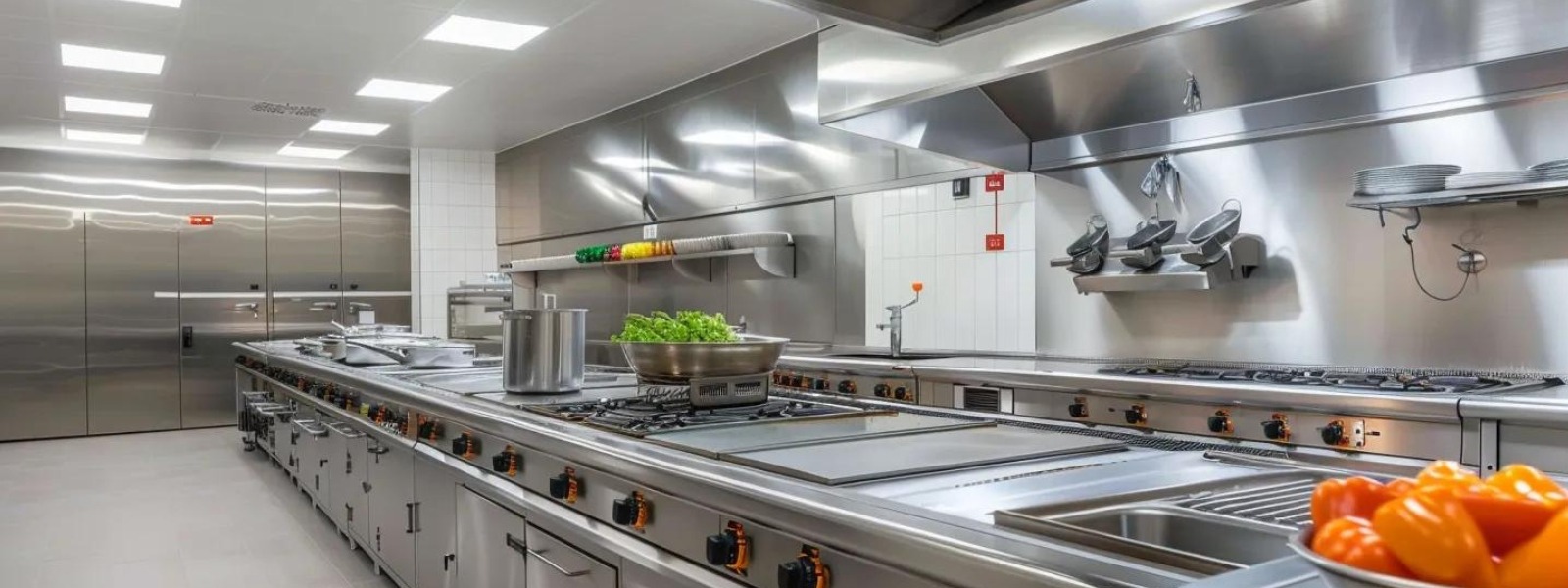
Regular kitchens follow no official regulations while commercial kitchens must meet strict health codes. Commercial kitchens follow strict local health codes and regulations with staff requiring food safety certifications. The regulatory burden for food service operations includes federal, state, and local requirements that home cooks never encounter.
Home cooks maintain cleanliness for family health without inspections or permits. Personal judgment determines sanitation practices. Commercial operators face legal liability for food safety failures. A single case of food poisoning can close a business permanently through lawsuits and regulatory action.
The FDA publishes the Food Code providing guidelines adopted by most jurisdictions. This document spans hundreds of pages covering topics from employee health policies to equipment specifications. OSHA enforces workplace safety rules protecting kitchen staff from burns, cuts, slips, and repetitive stress injuries. Local fire marshals inspect suppression systems and emergency exits.
Commercial kitchens need food handler licenses, food protection manager certificates, retail food business licenses, and health permits. Food handler licenses demonstrate knowledge about safe food handling practices and remain mandatory for chefs and kitchen staff. Every employee touching food must complete training and pass examinations covering topics like temperature control, cross-contamination prevention, and personal hygiene.
The FDA checks food safety while OSHA focuses on worker safety. State and local health departments enforce additional rules beyond federal minimums. Commercial kitchens undergo regular inspections to remain compliant with local health department regulations. Inspection frequency varies by jurisdiction but typically occurs 1-4 times annually with additional surprise visits following complaints.
Food Protection Manager certification requires completing an accredited course and passing a proctored exam. The ServSafe program represents one popular certification path recognized nationwide. Managers learn advanced concepts like HACCP principles, allergen management, and crisis response. This certification must remain current through renewal every 3-5 years depending on state requirements.
Commercial kitchens must install proper hand-washing stations, ventilation systems, fire suppression equipment, and grease traps. Commercial kitchens need at least one hand-washing station per every nine employees with potable water and soap. Hand sinks must be separate from food prep or dishwashing sinks to prevent contamination.
Floor surfaces must use smooth, durable, nonabsorbent material for easy cleaning. Acceptable flooring includes quarry tile, sealed concrete, or commercial-grade sheet vinyl. Walls and ceilings require approved hygienic materials that withstand moisture and cleaning chemicals. Ventilation systems must cover all cooking equipment including ranges, grills, ovens, and fryers.
Fire suppression systems cost $2,000 to $6,000 including installation. These systems use wet chemical agents that extinguish cooking oil fires more effectively than water or dry chemicals. Grease trap installation costs $1,000 to $3,000 to prevent sewage system damage. These safety features protect workers and customers from injury while preserving property and public infrastructure.
How Much Do Regular and Commercial Kitchens Cost?
Regular kitchens cost $15,000 to $50,000 for remodeling while commercial kitchens cost $15,000 to $250,000+ for setup. Restaurant equipment purchases from trustworthy dealers range between $40,000 to $200,000 on average. These costs reflect complete installations including equipment, installation labor, and necessary infrastructure upgrades.
Home kitchen costs include cabinets, countertops, appliances, flooring, and lighting. Cabinets typically consume 40-50% of remodeling budgets. Countertops add 10-15%. Appliances account for 15-20%. The remaining budget covers flooring, plumbing, electrical, and finishing details. Commercial kitchen costs include equipment, design services, construction, permits, ventilation, and fire safety systems. Equipment dominates expenses at 50-60% of total costs.
Design services prevent expensive mistakes during construction. Professional kitchen designers charge $2,000-$10,000 for complete planning including layout drawings, equipment specifications, and construction documentation. This investment saves money by optimizing workflow, preventing code violations, and confirming equipment fits properly.
Equipment purchases, design services, construction work, permits, and ventilation systems affect commercial kitchen costs. Kitchen equipment takes up the majority of restaurant startup costs because businesses invest in expensive quality appliances that avoid annual replacement costs. Buying quality equipment once costs less than replacing cheap equipment repeatedly.
Fire suppression systems cost $2,000 to $6,000 including installation. HVAC systems cost $4,000 to $12,000 or more depending on space size and kitchen needs. Proper ventilation maintains comfortable working temperatures and removes smoke, steam, and cooking odors. Plumbing upgrades cost $1,000 to $3,000 for additional sinks, drain lines, and grease traps. Electrical work costs $2,000 to $5,000 for new circuits, outlets, and service panel upgrades. Commercial kitchens need 200-400 amp electrical service compared to 100-200 amp service in homes. Homeowners planning kitchen updates should explore kitchen cabinet remodeling budgets to understand residential cost factors.
Businesses save money by buying used equipment, renting kitchen space, purchasing in bulk, and starting small. Buying used restaurant equipment saves money as many restaurant owners upgrade regularly, offering high-quality equipment at lower cost. Used equipment costs 50-70% less than new while providing years of service.
Many communities offer co-op commercial kitchens shared by numerous vendors, providing needed equipment at modest ongoing costs. Shared kitchen rentals cost $15-$40 per hour or $500-$2,000 monthly depending on location and amenities. Renting avoids construction expenses and lets food businesses test concepts before permanent investment.
How Do Storage Needs Differ Between Kitchen Types?
Regular kitchens use cabinets and one refrigerator while commercial kitchens use walk-in coolers, walk-in freezers, and multiple storage rooms. Commercial kitchens feature extensive cooking stations and storage areas handling large volumes of raw materials. Storage capacity must match production volume to prevent stockouts during service or waste from spoilage.
Home storage holds food for 3 to 5 people for one week. Families shop weekly or biweekly and keep modest inventories. Commercial storage holds ingredients for 50 to 500 customers for one day. Restaurants receive deliveries 3-7 times weekly depending on menu and storage capacity. The sheer volume of utensils, cutlery, pots, plates, and pans needs storage space beyond residential kitchen capacity.
A single commercial kitchen might stock 200-500 pounds of protein, 100-200 pounds of vegetables, 50-100 pounds of dry goods, and 30-50 gallons of dairy products at any time. This inventory turns over rapidly during busy periods.
Commercial kitchens use walk-in refrigeration, dry storage rooms, shelving units, under-counter storage, and prep table storage. Walk-in coolers provide room-sized refrigeration maintaining temperatures between 34-38°F. Walk-in freezers store frozen goods at -10 to 0°F. These units range from 6x6 feet to 12x20 feet depending on restaurant size.
Dry storage rooms hold bulk ingredients like flour, rice, sugar, and canned goods. These climate-controlled spaces maintain temperatures around 70°F with humidity below 60% to prevent pest problems and food degradation. Food must sit 6 inches above floors to prevent pest access and facilitate cleaning. Custom pantry cabinetry helps homeowners organize food storage effectively in residential kitchens.
How Do Daily Operations Differ Between Kitchen Types?
Regular kitchens operate casually with 1 to 2 cooks making 1 to 3 meals daily while commercial kitchens run continuously with teams producing dozens to hundreds of meals. Commercial kitchens handle large turnover and high output with designs supporting heavy-duty food production. The pace and pressure levels differ dramatically between these environments.
Home cooking follows personal timing without strict schedules. Dinner happens when ready regardless of exact time. Commercial cooking demands precise timing and coordination. Tables receive appetizers, entrees, and desserts in proper sequence. Multiple orders fire simultaneously requiring careful orchestration.
Commercial kitchens produce 100-400 meals during 2-3 hour dinner rushes. This concentration of activity requires military-like precision. Home kitchens produce 1-3 meals spread across several hours without pressure. Ticket systems or kitchen display screens coordinate commercial cooking. Servers enter orders that print or display in the kitchen by station.
Commercial kitchens organize workflow using dedicated stations for prep, cooking, plating, and dishwashing. Multiple stations handle dedicated tasks from chopping through plating. Station types include prep areas washing and chopping vegetables, grill stations cooking proteins, fry stations making fried items, sauté stations finishing vegetables and sauces, baking stations producing breads and desserts, and plating areas assembling finished dishes. Understanding cabinet organization principles helps both commercial and residential kitchens function smoothly.
What Maintenance Requirements Apply to Each Kitchen Type?
Regular kitchens need basic daily cleaning while commercial kitchens require rigorous sanitization multiple times daily. Commercial kitchens uphold rigorous cleaning and sanitation practices maintaining hygienic and safe conditions. The cleaning intensity and frequency far exceeds home standards due to health regulations and liability concerns.
Home cleaning involves wiping counters, washing dishes, and occasional deep cleaning. Most families spend 15-30 minutes cleaning after meals. Deep cleaning happens monthly or quarterly covering areas like ovens, refrigerators, and floors. Commercial cleaning includes sanitizing prep surfaces after each use, deep cleaning equipment, mopping floors multiple times, and professional deep cleaning services.
Commercial kitchens sanitize equipment after each use, deep clean daily, and service equipment weekly or monthly. Daily tasks include sanitizing prep surfaces, deep cleaning cooking equipment, mopping floors, and cleaning grease traps. Weekly or monthly maintenance includes deep cleaning ovens and grills, defrosting freezers, cleaning ventilation systems, servicing equipment, and pest control.
Professional cleaning crews perform deep cleaning after closing. This maintains health inspection readiness and food safety standards. Deep cleaning costs $200-500 per session depending on kitchen size. Maintenance contracts for refrigeration, HVAC, and fire suppression systems cost $200-500 monthly depending on equipment quantity.
Which Kitchen Type Should Different People Choose?
Home cooks need regular kitchens while food business operators need commercial kitchens. Regular kitchens suit family cooking, comfortable spaces, and personal schedules. Commercial kitchens serve restaurants, catering companies, and food service businesses preparing large food quantities for events, parties, and weddings.
Hobby bakers selling cookies at farmers markets face difficult decisions. Some jurisdictions allow cottage food operations from home kitchens with limitations. Others require commercial facilities for any food sales. Food trucks need commissary kitchens for prep, storage, and cleaning beyond truck capacity. Commissary rental costs $300-$800 monthly providing prep space, storage, and waste disposal.
Most jurisdictions prohibit selling food cooked in home kitchens. Legitimate food businesses must cook and bake in commercial kitchens licensed by local health agencies. This requirement protects public health by proper food handling in inspected facilities.
Some states allow cottage food operations under specific conditions. Texas, California, and Florida permit selling certain low-risk items like baked goods, jams, and candies. Sales must be direct to consumers rather than through stores. Annual gross sales caps range from $25,000 to $50,000. Products require labels listing ingredients and allergens plus disclaimers about unlicensed production. Just as homeowners research cabinet replacement timing, aspiring food entrepreneurs should research production facility requirements.
How Do Energy and Utility Needs Compare?
Regular kitchens use standard residential utilities while commercial kitchens need industrial-capacity utilities. Commercial equipment uses much more energy including both gas and electricity with higher utility costs than residential equipment.
Home kitchens use 5% to 10% of household energy. Appliances sit idle most hours. Refrigerators run continuously but use 100-200 watts. Ovens operate 1-2 hours daily drawing 2,000-5,000 watts. Monthly energy costs for residential cooking total $30-$80. Commercial kitchens operate 8 to 16 hours daily with all equipment running simultaneously.
Commercial refrigeration runs continuously drawing 1,000-3,000 watts per unit. Ranges use 30,000-60,000 BTUs per hour of gas. Ovens consume 20,000-50,000 BTUs hourly. Dishwashers heat 140-180°F water using 5,000-10,000 watts. Monthly energy costs for commercial kitchens range $1,000-$5,000 depending on menu, volume, and efficiency.
Commercial kitchens require multiple electrical circuits, industrial gas lines, high water pressure, and heavy-duty exhaust systems. Residential electrical panels provide 100-200 amp service. Commercial kitchens need 200-400 amp service split across multiple circuits. Each piece of major equipment needs dedicated circuits preventing overloads.
Utility bills for commercial kitchens run 10 to 20 times higher than home kitchens. Energy-efficient equipment reduces long-term costs through lower consumption. Energy Star rated equipment uses 10-30% less energy than standard models. Professional installation matching commercial services standards maintains safety and functionality.
What Layout Differences Exist Between Kitchen Types?
Regular kitchens prioritize aesthetics and social interaction while commercial kitchens prioritize workflow efficiency and production capacity. Home kitchen layouts often feature the work triangle connecting sink, stove, and refrigerator within 12-26 feet total. This arrangement minimizes steps during cooking. Islands provide additional prep space and seating for casual dining.
Commercial layouts follow linear or zone patterns optimizing throughput. The work triangle expands into work zones handling receiving, storage, prep, cooking, holding, and dishwashing. Traffic flows one direction from raw ingredients through finished products preventing cross-contamination.
Commercial kitchens dedicate 25-35% of space to cooking equipment, 15-20% to prep areas, 10-15% to dishwashing, 20-30% to storage, and 10-15% to circulation. Home kitchens dedicate 40-50% of space to storage, 20-30% to prep, 15-20% to cooking, and 10-15% to circulation reflecting different priorities.
Stainless steel dominates commercial kitchens for sanitation and durability. Walls use fiberglass-reinforced panels. Floors use non-slip tile or sealed concrete. Home kitchens use decorative materials like wood cabinets, granite counters, and tile backsplashes creating warmth and personal style. Selecting appropriate cabinet colors influences how lighting affects residential kitchen appearance.
What Role Does Technology Play in Each Kitchen Type?
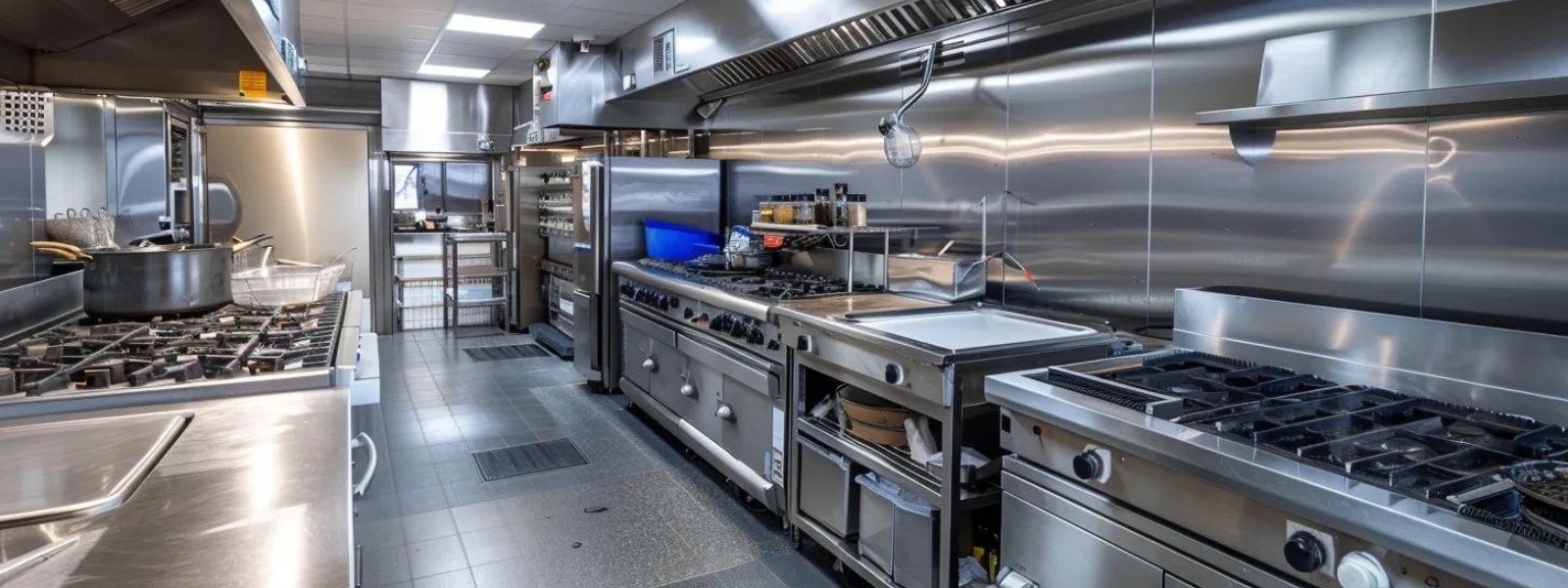
Regular kitchens incorporate convenience technology while commercial kitchens use production management technology. Home kitchens might include smart appliances with Wi-Fi connectivity, touchscreen controls, and app integration. Smart refrigerators track inventory and suggest recipes. These features add convenience without being essential to cooking function.
Commercial kitchens implement point-of-sale systems, kitchen display screens, inventory management software, and scheduling platforms. POS systems cost $2,000-$10,000 for hardware and software. These systems track sales, manage orders, control inventory, and generate reports.
Inventory management software tracks food costs and prevents waste. Programs monitor usage rates, predict ordering needs, and calculate recipe costs. Scheduling software manages labor costs and provides adequate staffing. Labor typically represents 25-35% of restaurant revenue making efficient scheduling crucial to profitability.
Temperature monitoring systems use wireless sensors tracking refrigeration units and holding equipment. Alerts notify managers of temperature excursions before food spoils or becomes unsafe. Recipe management software scales ingredient quantities and calculates nutrition information.
How Do Sanitation Standards Differ Between Kitchen Types?
Regular kitchens follow personal hygiene preferences while commercial kitchens follow codified sanitation protocols. Home cooks wash hands before cooking and after handling raw meat. Sponges and towels get replaced when they seem dirty. Cutting boards might be washed with dish soap and water. These casual practices work fine for family cooking without formal structure.
Commercial sanitation protocols specify exactly how, when, and what to clean. Hand washing must occur after specific activities using proper technique for 20 seconds with soap and water. Paper towels must be available for drying. Reusable towels are prohibited in food contact areas. Cutting boards require sanitizing after each use with approved chemicals or 180°F water.
Three-compartment sinks follow strict procedures: wash in 110°F soapy water, rinse in clean water, sanitize in chemical solution or 171°F water for 30 seconds. Test strips verify proper chemical concentration. Air drying is mandatory since towel drying could recontaminate items. These procedures prevent cross-contamination and pathogen growth.
Color-coded equipment separates uses. Red cutting boards handle raw meat, yellow handles raw poultry, green handles produce, white handles dairy, and blue handles seafood. This system prevents cross-contamination through visual cues. Home kitchens might use one or two cutting boards without color coding.
Food temperature logs document holding temperatures throughout service. Cold foods must stay below 41°F. Hot foods must stay above 135°F. The danger zone between these temperatures allows rapid bacterial growth. Logging creates legal documentation proving proper handling. Home cooks check temperatures occasionally without formal record keeping.
Frequently Asked Questions
Can I use Commercial Equipment in My home kitchen?
Yes, homeowners can install commercial equipment in residential kitchens but face higher costs and energy consumption. Commercial appliances require upgraded electrical service, gas lines, and ventilation systems. Installation costs run $5,000-$15,000 beyond equipment prices. Commercial ranges use 3-5 times more energy than residential models increasing utility bills significantly. Most homeowners find residential appliances adequate for family cooking needs.
How long does commercial kitchen equipment last?
Commercial kitchen equipment lasts 10-15 years with proper maintenance or 15-20 years with excellent care. Refrigeration units typically last 10-15 years. Ranges and ovens last 15-20 years. Dishwashers last 8-12 years. Preventive maintenance extends equipment life and prevents costly breakdowns during service. Budget 3-5% of equipment value annually for maintenance and repairs.
Do I need a Commercial Kitchen to Sell Baked Goods?
Requirements vary by state and local jurisdiction. Many states allow cottage food operations selling baked goods from home kitchens with restrictions. Annual sales limits range $25,000-$50,000. Products must be low-risk items like cookies, cakes, and breads. Sales must be direct to consumers. High-risk items like cream-filled pastries require licensed commercial facilities. Check local health department regulations before starting home-based food sales.
What is the Minimum Size for a Commercial Kitchen?
The minimum functional commercial kitchen measures 500-800 square feet for small operations. Food trucks and ghost kitchens operate in 200-400 square feet using specialized layouts. Full-service restaurants need 1,000-1,500 square feet for adequate production capacity. Kitchen size depends on menu complexity, customer volume, and service style. Proper layout matters more than total square footage for efficiency.
How Much do Commercial Kitchen Rental Spaces Cost?
Commercial kitchen rental costs vary by location and amenities. Hourly rentals range $15-$40 per hour. Monthly rentals cost $500-$2,000 for dedicated space. Shared commissary kitchens cost $300-$800 monthly with limited hours. Prime locations in major cities charge higher rates. Rental agreements typically include equipment, utilities, and insurance. This option lets food businesses test concepts without building permanent facilities.
Final Thoughts
Regular kitchens serve family cooking while commercial kitchens serve food businesses. Home kitchens prioritize comfort, appearance, and personal cooking. Commercial kitchens prioritize production volume, safety compliance, and business profitability. The differences extend beyond size to encompass equipment, regulations, operations, and purpose.
Each kitchen type serves different needs. Home kitchens make families happy with functional layouts and quality materials. Commercial kitchens help food businesses operate safely and efficiently with proper equipment and health compliance. Choosing the right type depends on intended use and legal requirements rather than personal preference.
Custom kitchen cabinets create perfect home kitchen spaces tailored to family needs. Professional design and quality construction ensure years of enjoyment and functionality. Commercial cabinetry services design and build solutions meeting safety requirements for food businesses.
Understanding these differences helps homeowners plan effective remodels and food entrepreneurs build compliant facilities. Investment in proper design and equipment pays dividends through efficiency, safety, and longevity. Contact Classic Cabinetry for kitchen consultations addressing specific needs and goals. Services cover Huntsville, Madison, Decatur, and surrounding Alabama areas with expert cabinet design and installation supporting both residential and commercial projects.

